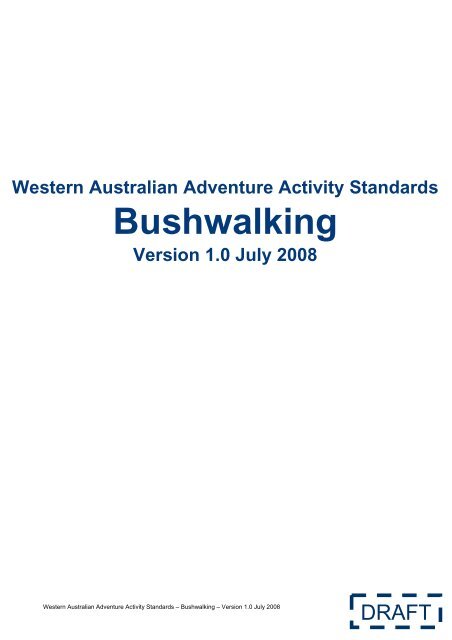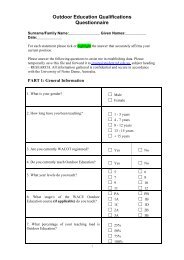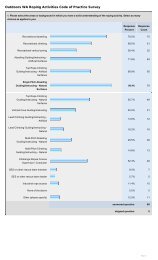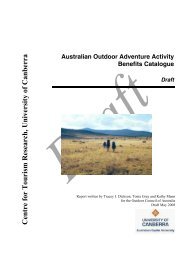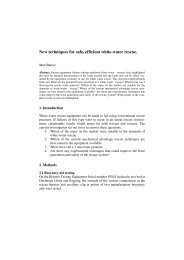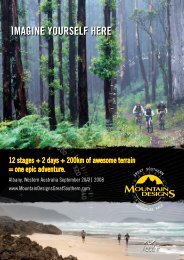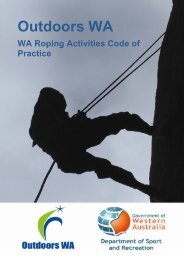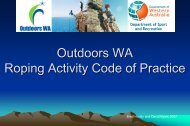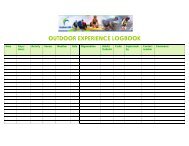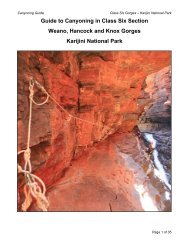Bushwalking - Outdoors WA
Bushwalking - Outdoors WA
Bushwalking - Outdoors WA
You also want an ePaper? Increase the reach of your titles
YUMPU automatically turns print PDFs into web optimized ePapers that Google loves.
Western Australian Adventure Activity Standards<strong>Bushwalking</strong>Version 1.0 July 2008Western Australian Adventure Activity Standards – <strong>Bushwalking</strong> – Version 1.0 July 2008 1DRAFT
Western Australian Adventure Activity Standard<strong>Bushwalking</strong> (DRAFT)Adventure Activity Standards benchmark the minimum industry requirements and responsibilitiesfor organisations and leaders conducting outdoor adventure activities for commercial and non –commercial groups.The Adventure Activity Standards are designed to be applied when the participants are, for thepurposes of participating in the bushwalking activity, either• In a pre-existing groupo Where either the group members (and or its representative third party) have made acollective purchase of / collective decision to participate in the activity (ie a school, corporateor community group); or are• Formed into a new groupo Where the participants have purchased / made the decision to participate in the activity asindividuals or smaller groups, but having done so become a part of a new group (ie citizensor tourists who, having purchased an activity from an organisation or leader individually, areformed into a group for the purposes of participating in the activity provided).In all cases the relationship between the group of participants and the activity provider is onebased upon dependence by way of contract and or duty of care.The existence of other types of groups where the group is less defined and NOT dependent as agroup upon an activity provider for the conduct of the activity is acknowledged. (ie independentclub members participating in an activity). It is intended that such less defined groups ofindependent participants are not “captured” by the AAS.The Western Australian Adventure Activity Standards were developed by an industry wideconsultative process coordinated by <strong>Outdoors</strong> <strong>WA</strong> following the recommendations of the 2006State Government Adventure Tourism Visitor Safety Task Force Report. The Project receivedgrant funding via the Department of Sport and Recreation.The development and implementation of the AAS allows the outdoor adventure industry todemonstrate its collective integrity and agreed standards. This, in turn will provide a measure ofquality for the purposes of assisting1. Consumers of our services to make informed choices about the services they select2. Training organisations to produce graduates who understand and meet industry standards3. Media, insurance and legal scrutineers of our industry and its members, to understand what isacceptable practice and what is not4. The development of sustainable use practices that consider the specific natural and cultural heritagevalues of areas in which we conduct outdoor activitiesThe AAS are a critical component of the industry quality framework comprising four aligned andinter-connected components1. Accreditation - the required business operating standards for businesses and organisations2. Adventure Activity Standards - the minimum standards to which an activity must be conducted bya provider to dependent groups of participants3. Leader Competency / Registration Scheme - the responsibilities and competencies required of theleaders conducting the outdoor activities4. Codes of Conduct – the behavioural expectations of persons operating as outdoor leadersWestern Australian Adventure Activity Standards – <strong>Bushwalking</strong> – Version 1.0 July 2008 2
TABLE OF CONTENTSINTRODUCTION .............................................................................................................................. 4ACTIVITY DESCRIPTION ................................................................................................................ 4PLANNING AND PREPARATION ................................................................................................... 5Route / Campsite(s) Plan.......................................................................................................... 5Risk Management Plan............................................................................................................. 6Emergency Response Plan ...................................................................................................... 6Leader : Participant Ratios and Group Size.............................................................................. 7Minimal Environmental Impact Plan - Leave No Trace 7 Principles ......................................... 7REQUIREMENTS OF LEADERS..................................................................................................... 8Responsibilities of Leaders ....................................................................................................... 8Competencies of Leaders ......................................................................................................... 9Restricted <strong>Bushwalking</strong> Guide 9<strong>Bushwalking</strong> Guide (Tracked or Easy Untracked Areas) 10<strong>Bushwalking</strong> Guide (Difficult, Trackless and or Unmodified Areas) 11<strong>Bushwalking</strong> Instructors 12FIRST AID REQUIREMENTS ........................................................................................................ 12<strong>Bushwalking</strong> groups require leaders with first aid qualifications in addition to the competencieslisted above. The following framework guides the level of first aid qualification required fordifferent types of bushwalks...................................................................................................... 12REQUIREMENTS / RESPONSIBILITIES OF ORGANISATIONS ................................................. 12EQUIPMENT................................................................................................................................... 13Participant’s Equipment .......................................................................................................... 13Leaders’ and Group Equipment .............................................................................................. 13DEFINITION OF TERMS ................................................................................................................ 13ACKNOWLEDGEMENTS .............................................................................................................. 14FEEDBACK, REVIEW & APPEALS .............................................................................................. 14FURTHER INFORMATION ............................................................................................................ 14Western Australian Adventure Activity Standards – <strong>Bushwalking</strong> – Version 1.0 July 2008 3
INTRODUCTIONThe Western Australian Adventure Activity Standards (AAS) have been developed to assistorganisations and leaders to plan and conduct outdoor adventure activities with commercial andnon-commercial dependent groups of participants where there is a duty of care based in contractand or in authority.The purpose of the AAS is to maintain the perception of adventure whilst simultaneously reducing /managing the real risk for participants. Increased outdoor physical activity with reduced incidentand accident rates will be the ultimate performance indicators of the value of the AAS.The AAS provide a valuable resource for the development of operating procedures, and or for thepurposes of comparing existing operating procedures to industry agreed benchmarked standards.All groups differ in their collective skills and experience and in their degree of dependence uponthe leader. They participate in outdoor activities at a range of sites with varying conditions(including weather). It therefore remains the responsibility of the leader to make theprofessional judgements and decisions concerning the conduct of the activity to ensure thesafety of the group. The AAS are designed to assist such judgements and decision making.The AAS are also designed to promote knowledge and awareness of the broad and activityspecific impacts increasing recreation and travel opportunities place upon the natural environment.The AAS are designed to assist the protection of biodiversity values and the preservation ofcultural sites balanced with the increased access demands. The 7 Principles of Leave No Traceare imbedded within the AAS.Whist not statutory standards, the AAS provide the basis for policy formation and decision makingby jurisdictions external to the outdoor adventure activity industry including, but not restricted to,licensing, insurance and legal jurisdictions.ACTIVITY DESCRIPTIONThe activity of bushwalking involves walking in the natural environment for pleasure, challenge,experience and / or educational outcomes. The term ‘bushwalking’ is appropriately applied to long(multi day) as well as short (an hour or two) walks that can be experienced in diverse environmentsincluding urban suburbs, coastal, alpine, outback and remote regions.This AAS is intended to be applied in circumstances where the bushwalking experience is theprimary activity undertaken by a dependent group of participants.Western Australian Adventure Activity Standards – <strong>Bushwalking</strong> – Version 1.0 July 2008 4
PLANNING AND PREPARATIONThe AAS provides a planning and preparation framework considered critical in maximisingparticipant safety and enjoyment. All planning must be finalised and the relevant componentsdocumented before the activity is undertaken. A suggested planning and preparation frameworkincludes• Preliminary Information• Route / Campsite Plan(s)• Risk Management Plan• Emergency Response Plan• Minimal Environmental Impact PlanSamples and suggested templates are available at www.outdoorswa.orgPreliminary InformationThe following are the minimum information requirements for conducting a bushwalk• Objectives / desired outcomes of the session (recommended only)• Planned start and finish times (may also include sector times)• Leader to participant ratio and group size (refer Leader : Participant Ratios and Group Size)• Profile of the group (age (if relevant), fitness level / capability, experience)• Land / campsite manager requirements includingo Access restrictionso Group sizeso Booking and permit requirementso Regulations with regard to fire and the conduct of activitieso Current environmental management policies and biodiversity issues effecting the region(refer to www.naturebase.com.au)• Regulations in regard to fire restrictions, restrictions, bans, local conditions• Availability of suitable maps• Equipment requirements (refer Equipment)• Dependent participants’ names and emergency contact details• Medical information advised by dependent participants which may be relevant to the activityo Conditions – EG asthma, diabetes, epilepsy, fainting, allergic reactions, blood conditionswhich may effect bleeding/ blood clotting, recent or long-standing injuries, (eg back, knee,ankle), disability, psychological conditionso Medications - what is it / why is it required / how is it administered?• Group members are advised, in writing and or in a verbal briefing, ofo Potential risks associated with the activityo Zero tolerance requirements re drugs other than prescription drugs NOT effecting theparticipant’s ability to participateo The requirement to conform to responsible and attentive behaviouro Suggested physical requirements for the walk (EG “must be able to walk 20 kilometres a daycarrying a 30 kg pack”)• RECOMMENDED - Participant signed legal liability disclaimer (informed consent) / waiver to sue /authorisation to seek / provide emergency medical treatment (retain for a time frame as dictated bythe Statute of Limitations Act 2005); dependent participants under the age of 18 must have thesignature of a parent / guardian if required by the organisation that has legal responsibility for them• An understanding of the natural and cultural history / diversity of the site(s) / location(s)Route / Campsite(s) PlanThe purpose of the route / campsite(s) plan is to assess issues regarding access, environmentalimpact, risk and emergency communications relative to a particular site. The route / campsite(s)plan shall provide details of• Assessment of the suitability of the route / campsite(s) for the size and ability of the group• Access to and along the route / campsite(s)o by vehicle (2WD / 4WD) including emergency services vehicleso on foot including the best routes to take to minimise environmental impactWestern Australian Adventure Activity Standards – <strong>Bushwalking</strong> – Version 1.0 July 2008 5
• Where is / are the best place (s) to make an emergency contact (by mobile or satellite phone ifcoverage available, by radio or by a runner party to a land line, by EPIRB/PLB) and where is thebest place to make these calls from• Route / Campsite(s) characteristicso Weather forecast (temperature, wind, rain)o Potential risks; how these risks can be managedo Specific terrain / route characteristicso Availability of drinking watero Availability of sheltero Surface type & suitability• Contingency plans for forecast / foreseeable weather conditions• Opportunities for rest breaks and availability of shaded areas / shelter• Toileting facilities and appropriate waste disposal options• Location of any water sources• Location of any culturally significant areas, structures, artefacts or rock art that need to be avoided• Location of any rare or endangered plants or animals, or sensitive areas• Ability of route / campsite(s) to withstand visitation with minimal impact upon vegetationSamples and suggested templates are available at www.outdoorswa.orgRisk Management PlanThe purpose of the Risk Management Plan is to identify the human, route / campsite(s) specific,equipment and environmental risks for the safe conduct of the activity. By identifying, analysingand evaluating these risks, appropriate strategies to reduce / manage the risk can be developedand implemented. <strong>Bushwalking</strong> leaders must assess the chosen route / campsite(s) for potentialhazards and adapt the planning of the activity as required. Information with regard to any newhazard must be made available within the group / organisation and to the relevant land managerwhere appropriate.Samples and suggested templates are available at www.outdoorswa.orgThe Risk Management Plan must consider• Leader(s) have the required authorisation, skills, qualifications and experience too conduct the bushwalk in the selected environment(s)o satisfy the planned objectiveso effectively manage incidents (refer Requirements of Leaders)o preserve the environmental integrity of the route and campsite(s)• Leader : Participant ratio (refer Leader : Participant Ratios and Group Size)• Group size (refer Leader : Participant Ratios and Group Size)• Group profile includingo Skill / experience levelso Needs / requirementso Knowledge of environmental minimum impact strategieso Methods for managing the group at all times including walkers at the front, in the middle andat the end of your line of walkersEmergency Response PlanThe purpose of the Emergency Response Plan is to provide a set of steps for leaders to follow inthe event of an emergency which may include injury or death. The plan must include informationto assist the leader to minimise the escalation of the situation, the injuries incurred and how toreduce the likelihood of further incidents occurring. The Emergency Response Plan must be route /campsite(s) specific and document current details including• Access and egress options from the route / campsite(s) including sectors• Contingency plans for effective rescue with minimum environmental impact to the route / campsite(s)• Group assembly points• Emergency contact details which may includeo Next stage of definitive medical care (hospital, doctor)o Policeo Relevant Agencies (EG Department of Environment and Conservation, land owners, rescueservices, Department of Planning and Infrastructure)• Specific communication requirements / available networksWestern Australian Adventure Activity Standards – <strong>Bushwalking</strong> – Version 1.0 July 2008 6
ALL leaders must carry a copy and be fully aware of the emergency response plan (often includedas a part of the “route plan”). A copy of the emergency response plan must also be kept (with otherdocumentation) with a non-participating contact and be readily accessible by the leader via anavailable telecommunication method in the event of an emergency.The leader is to communicate with the relevant external contact at a designated time(s). Uponfailure to do so the external contact must action the emergency response plan which may includecontacting the police. In situations where there is only one leader, the emergency response planshall have been introduced to, and be available to members of the group so that it may be actionedin the event that the leader becomes unfit to do so.Samples and suggested templates are available at www.outdoorswa.orgLeader : Participant Ratios and Group SizeWhilst it is acknowledged that the characteristics of the route / campsite(s), the profile of the group,the purposes of the bushwalk, and the experience of the leader will influence the ratios of leadersto dependent participants, the minimum ratios considered acceptable are• Day and Overnight Walks – AS Track Grades 1,2,3,4,5,6Operational Ratio for u/18 year old dependent participants – applicable for recognised leader with additionalresponsible adult to actual dependent participants 1:1:22Operational Ratio for o/18 year old dependent participants – applicable for recognised leader to actualdependent participants 1:22NOTES:1. On AS Track Grades 1,2,3 there is no minimum group size2. On AS Track Grades 4,5,6 the MINIMUM group size is 4Group size will be determined by route and campsite(s) characteristics, land managerrestrictions, environmental considerations and the application of the above ratios.Minimal Environmental Impact Plan - Leave No Trace 7 Principles1. Plan Ahead and Prepare*• Know the regulations for and special concerns of the area in which you’d like to bushwalk• Be aware of the biodiversity values and threats of the region and the specific condition of the locality• In the South West Ecoregion, a world biodiversity hotspot, access detailed information aboutoccurrence of Phytophthora Dieback2. Travel and Camp on Durable Surfaces*• Stay on durable surfaces, which include established tracks, rock, gravel and dry grasses wherepractical• Always walk on the track even if wet and muddy, to avoid widening it (with the exception ofPhytophthora areas where one should avoid mud)• On narrow paths walk in single file as much as possible to avoid widening the track• Manage groups to minimise disturbance to vegetation to reduce erosion and the spread of pest plantspecies• Avoid revegetation areas altogether3. Dispose of Waste Properly*• Pack and carry out all rubbish including leftover food and organics• Inspect your campsite and rest areas for rubbish and spilled food before leaving• Be careful not to drop rubbish while walking• Human waste and waste water should be disposed of at least 100 metres from any waterway• When available, use established toilet facilities4. Leave What You Find*• It is illegal to excavate, disturb or remove archaeological, historical and cultural artefacts from anypublic or wilderness landsWestern Australian Adventure Activity Standards – <strong>Bushwalking</strong> – Version 1.0 July 2008 7
• Respect indigenous sites to ensure their longevity; land managers can advise you on these locations• Do not touch rock art, which can be damaged by the natural oils from human skin• Leave rocks, plants and other natural objects as you find them• Avoid spreading non-native plant and animal species that are generally impossible to eradicate oncethey are introduced; do not transport flowers, weeds, wood or aquatic plants into or out of thewilderness• Avoid transporting mud in then soles of boots, on tent pegs and walking poles by washing thoroughlybefore and after travelling; use wash stations immediately where provided• Check clothing and all gear and burn or dispose of all hitchhiker type seeds before and aftertravelling in different areas5. Minimise Campfire Impacts*- use a fuel stove• Observe Total Fire Bans and campfire regulations; liaise with local land management staff• Use a lightweight stove for cooking or use a candle lantern for light when possible• Where fires are permitted, use designated, constructed fireplaces only• Keep fires small; use of fallen fuel and sticks• Extinguish fire completely6. Respect Wildlife*• Minimise noise at campsites• Minimise interaction with wildlife including feeding7. Consider Your Hosts and Other Visitors*• Do not block paths or tracks with people or equipment• Respect the wishes and regulations of all hosts – indigenous, pastoral, land managers and locals* Further information is available at Leave No Trace Australia www.lnt.org.auREQUIREMENTS OF LEADERSThe performance of the leader is a critical factor in the safe conduct of a bushwalking activity. Theleader is required to• Accept responsibility for the planning, preparation and conduct of the activity• Maintain current skills, qualifications and experience as required• Accept responsibility for the environmental preservation of the sites and surrounding areasThis does not exclude the fact that dependent participants are responsible for their own actions inrelation to the potential risks that may be encountered by choosing to participate in a bushwalkingactivity.Responsibilities of LeadersLeaders are required to accept the following responsibilities• To ensure that ALL required competencies as outlined in “Competencies of Leaders” are available tothe group for the walk, if not within his / her competency profile then within the collective of his / herco-leaders• To use their judgement to make decisions that will ensure the safety of all group members andmaintain the integrity of the environment including matters relevant too People based risks*• Collect all documentation / forms signed by all dependent participants / parents orguardians (or ensure data is collected by the third party responsible for the group)• Communicate the anticipated risks relating to the activity to the group in a preactivitybriefing, and others that arise during the walk• Match the experience / capabilities of the group to the activity• Be aware where participants have stored / are carrying their personal medications• Ensure all significant incidents and accidents are documented and reported inwriting to the organisation sanctioning the walk within seven (7) days of thecompletion of the walk or as soon as is practicalo Ideally the sanctioning organisation will in turn communicate suchincident(s) or accident(s) to <strong>Outdoors</strong> <strong>WA</strong> in writingo Site / route based risks*• Be familiar with the selected site(s) / route(s) and the scope of variation of conditionsWestern Australian Adventure Activity Standards – <strong>Bushwalking</strong> – Version 1.0 July 2008 8
oolikely to be encountered; check weather forecasts and water obstacles pre -departure• Appropriately manage hazards that are encountered• Consider the availability of drinking water on route and have appropriatecontingency plans• Be aware of and comply with the land / site manager’s guidelines including minimalimpact• Notify nominated external contacts of safe return / completion when appropriateEquipment based risks*• Check suitability, condition and use of all equipment prior to departure• Ensure correct use of equipment by all dependent participants• Ensure that a First Aid Kit and communication equipment suitable for the route arein good orderEnvironmental based risks*• Apply Leave No Trace Principles• Comply with the land / site manager’s guidelines including minimal impact principlesrelative to flora, fauna and rubbish removal• Report all environmental damage to the appropriate land manager• Report any perceived breaches of the <strong>Bushwalking</strong> AAS to <strong>Outdoors</strong> <strong>WA</strong>Competencies of LeadersLeaders require a range of technical and group facilitation skills to effectively conduct groupbushwalking activities. Leaders are deemed to be competent to the national standard to leadbushwalking activities if• They are currently registered in the National Outdoor Leader Registration Scheme (NOLRS)* as abushwalking guide or instructor (NOLRS is administered by <strong>Outdoors</strong> <strong>WA</strong> on behalf of the OutdoorCouncil of Australia) which requireso A recognised qualification or skill seto Sufficient current experienceo Appropriate first aid qualifications• Within one hour from definitive medical care – Senior First Aid required• Beyond one hour from definitive medical care – an advanced / wilderness / remoteFirst Aid qualification is required* registration with NOLRS must be achieved by 30 December 2009* further information about NOLRS including how to register is available at www.outdoorswa.org*the registration achieved must align with the specific form of bushwalking to be undertaken ie.<strong>Bushwalking</strong> Guide – Tracked or Easy UntrackedOR IF• They are “signed off as sufficiently competent for the walk” by the organisation sanctioning the walkwhereby such “sign off” is based upon the following competency framework and where theorganisation accepts that the leader’s competence may not have been formally assessed againstnor recognised as meeting the national standardRestricted <strong>Bushwalking</strong> GuideA person designated as a Restricted <strong>Bushwalking</strong> Guide has the skills, fitness, knowledge andexperience to work autonomously within a defined range of skilled operations involving knownroutines, methods and procedures, where a small amount of discretion and judgment is required inthe selection of equipment, services or contingency measures. The Restricted Guide mayindependently guide bushwalks up to one full day in specific geographic areas / on specific tracksas defined as Class 1, 2 or 3 within the Australian Standard Walking Tracks Part 1: Classificationand Signage (AS 2156.1—2001) but only when• He / she is fully aware of the defined context of the walkWestern Australian Adventure Activity Standards – <strong>Bushwalking</strong> – Version 1.0 July 2008 9
• The range of options for the walk (ie in route selection) is minimal• There are clearly defined / documented Standard Operating Procedures (SOP’s)• A specific risk management plan for the selected track and location is available• Assistance is readily available using routine communication techniques / strategies should a nonroutinesituation arise (mobile phone, radio, easy access to external assistance)• The route is tracked and signed (ie. where tracks are reliably marked on maps and are obvious onthe ground with obvious signs and track markers for direction)• A minimum level of specialised skills is required to negotiate natural hazards such as steep slopes,unstable surfaces and minor water crossings• Extremes of weather are historically unlikely in the location• “Supervision” is provided indirectly through application of a documented risk management plan forthe specific walk location(s) and type of client group. (This documented risk management plan musthave been developed or reviewed by a person with greater competence and experience than theproposed guide (preferably including knowledge of the location(s) of the walk) OR by anorganisational process that avails the guide of operating procedures developed to minimize risk toparticipants (EG standard organisational operating procedures).A Restricted <strong>Bushwalking</strong> Guide must possess the skills, knowledge and experience that enable them to• Plan and implement minimal environmental impact by applying LNT principles• Implement a risk management plan• Interpret and apply weather forecasts• Comply with relevant legislation including fires and other relevant matters• Manage groups effectively• Demonstrate bushwalking skills including basic map reading skills• Respond to emergency situations; implement an emergency response planPersons with this level of competence may also work as an assistant with a more experiencedguide in potentially non-routine or more complex activities and programs (eg. bushwalks in trackedor easy untracked areas).<strong>Bushwalking</strong> Guide (Tracked or Easy Untracked Areas)A person designated as a <strong>Bushwalking</strong> Guide (Tracked and Easy Untracked) has the skills, fitness,knowledge and experience to work autonomously within a limited range of skilled operationsinvolving known routines, methods and procedures, where discretion and judgment is required inthe selection of equipment, services or contingency measures. The <strong>Bushwalking</strong> Guide mayindependently guide half day, full day overnight and multi day bushwalks in multiple geographicareas on multiple tracks or easy untracked terrain as defined as Class 1, 2, 3 or 4 within theAustralian Standard Walking Tracks Part 1: Classification and Signage (AS 2156.1—2001) when• He / she is fully aware of the context of the walk all be it potentially less defined than that of aRestricted Guide• The range of options for the walk (ie in route selection) is limited• There are documented Standard Operating Procedures (SOP’s)• A specific risk management plan for the selected route and campsite(s) is available• The route is tracked or easy untracked and maybe signed (ie. where there are significant landmarksto assist navigation and tracks are reliably marked on maps / are obvious on the ground, althoughthere may be no major modifications to the ground surface• Assistance is available within approximately 3 hours using routine communication techniques suchas mobile phone, satellite phone or radio (ie. leaders need to be self-reliant, particularly in regard toemergency first aid and weather hazards)• Access to external assistance or safe collecting feature (IE. a road) is easily reached by applyingnavigation principlesWestern Australian Adventure Activity Standards – <strong>Bushwalking</strong> – Version 1.0 July 2008 10
• “Supervision” is provided indirectly through application of a documented risk management plan forthe specific walk location(s) and type of client group. (This documented risk management plan musthave been developed or reviewed by a person with greater competence and experience than theproposed guide (preferably including knowledge of the location(s) of the walk) OR by anorganisational process that avails the guide of operating procedures developed to minimize risk toparticipants (EG standard organisational operating procedures).A <strong>Bushwalking</strong> Guide (Tracked or Easy Untracked Areas) must possess all the skills, knowledgeand experience required of a Restricted <strong>Bushwalking</strong> Guide PLUS those that enable them to:• Manage risk in outdoor activities• Provide leadership to groups• Use and maintain a temporary or overnight campsite• Navigate using a map and compass in untracked areas• Operate suitable communications systems and equipment• Guide bushwalks in tracked or easy untracked areas• Demonstrate shallow river crossingsPersons with this level of competence may also work as an assistant with a more experiencedguide in potentially non-routine or more complex activities and programs (eg. bushwalks in difficult,trackless and unmodified areas).<strong>Bushwalking</strong> Guide (Difficult, Trackless and or Unmodified Areas)A person designated as a <strong>Bushwalking</strong> Guide (Difficult, Trackless and or Unmodified Areas) hasthe skills, fitness, knowledge and experience that enable them to work independently within avariety of settings and contexts that may be complex and non-routine. Leadership and guidanceare involved when organising group activities as well as managing technical solutions of a nonroutineor contingency nature. A <strong>Bushwalking</strong> Guide (Difficult, Trackless and or Unmodified Areas)has the knowledge, skills and experience to lead dependent participants on bushwalks up to andincluding tracks defined as Class 5 within the Australian Standard Walking Tracks Part 1:Classification and Signage (AS 2156.1—2001). They will have the capacity to guide multi-daybushwalks along tracks which may be in multiple, difficult and trackless geographic locations when• They can work independently in a broad range of locations with a variety of different participantgroups and can manage non-routine situations• There are no / limited modifications to the natural surface and or the route alignment is indistinct inplaces• There is no / minimal clearance along the route and there may be debris• Signage is minimal and at best only for management purposes (ie limited directional signage)• There are terrain and man-made hazards (such as cliff lines or dense forests) and there may besteep sections of unmodified surface• A high degree of specialised skills (including advanced navigation skills), as well as maps andnavigation equipment are required to successfully complete the walk• They can be self-reliant, particularly in regard to emergency first aid and weather fluctuations• There is an appreciable risk of onset of extreme environmental conditions (eg. poor visibility,extreme heat/cold or wind) which may affect navigation and safetyA <strong>Bushwalking</strong> Guide (Difficult, Trackless and or Unmodified Areas) must have the ability tobushwalk in a bushland, arid, alpine, or rainforest area defined as difficult or trackless for aminimum period of two day's duration in different seasons when extreme environmental conditionsare not anticipated, although the possibility for changes in weather and visibility exists.A <strong>Bushwalking</strong> Guide (Difficult, Trackless and or unmodified Areas) must possess all the skills,fitness, knowledge and experience required of a <strong>Bushwalking</strong> Guide (Tracked or Easy UntrackedAreas) PLUS those that enable them to:• Interpret weather conditions in the field• Demonstrate bushwalking skills in difficult, trackless and unmodified areas• Navigate in difficult and trackless areasWestern Australian Adventure Activity Standards – <strong>Bushwalking</strong> – Version 1.0 July 2008 11
• Demonstrate safe river crossing skills in deep water• Guide bushwalks in difficult and trackless areas• Coordinate emergency responseA Guide with this level of competence may perform a broad range of skilled applications. Thesemay include the evaluation and analysis of current practices, development of new criteria andprocedures for performing current practices and provision of some leadership and guidance toothers in the application and planning of the skills.A <strong>Bushwalking</strong> Guide (Difficult, Trackless and or Unmodified Areas) must have the ability tobushwalk in a minimum of two different types of area (eg, arid and alpine, rainforest and bushland)defined as unmodified landscapes whilst carrying a pack equipped with provisions for extendedovernight expeditions (greater than two nights) in different seasons where there is an appreciablerisk of onset of extreme environmental conditions (eg. poor visibility, extreme heat/cold or wind).<strong>Bushwalking</strong> Instructors• Tracked or Easy Untracked Areas• Difficult and Trackless Areas / Unmodified LandscapesA person designated as a <strong>Bushwalking</strong> Instructor at any of the above 2 levels has the skills,knowledge and experience to facilitate skill transfer to or development within others in order thatthey may then guide other groups and or bushwalk independently in the type of terrain asdescribed in the level instructed. This requires the Instructor to be able to transfer required skillsand knowledge, apply a variety of appropriate instructional strategies and assess the client’s skilland knowledge acquisition during and at the end of a program or session.A person designated as a <strong>Bushwalking</strong> Instructor has the knowledge, skills and experience of a<strong>Bushwalking</strong> Guide as well as additional skills and experience in training and assessment.A <strong>Bushwalking</strong> Instructor must possess all the skills, knowledge and experience required of a<strong>Bushwalking</strong> Guide, PLUS those that enable them to:• Train and assess small groups• Instruct bushwalking in Unmodified LandscapesFurther details are available at www.outdoorswa.orgFIRST AID REQUIREMENTS<strong>Bushwalking</strong> groups require leaders with first aid qualifications in addition to the competencieslisted above. The following framework guides the level of first aid qualification required for differenttypes of bushwalks.• Urban Walks (less than half a day) - Basic first aid knowledge• Bushwalks (half to full day) - Basic first aid knowledge / Senior First Aid (or equivalent)• Multi Day Bushwalks - Senior First Aid• Remote Wilderness Walks - Advanced, Remote or Wilderness First AidREQUIREMENTS / RESPONSIBILITIES OF ORGANISATIONSOrganisations sanctioning the conduct of bushwalking activities for dependent groups of peopleare required to• Maintain current appropriate insurance• Report incidents and accidents to relevant jurisdictions in writing within seven(7) dayso Insurerso Land Managerso <strong>Outdoors</strong> <strong>WA</strong> (recommended)• Provide leaders with the necessary resources to conduct the bushwalk in accordance with allaspects of this StandardWestern Australian Adventure Activity Standards – <strong>Bushwalking</strong> – Version 1.0 July 2008 12
• Notify nominated external contacts of safe return / completion when appropriate• Verify and accept responsibility for the current competence of leaders selected for bushwalkingactivitiesEQUIPMENTEquipment requirements vary with the objectives of the activity, the group characteristic profile andthe environmental conditions likely to be encountered. When planning equipment requirements fora bushwalk it is important to consider all possible eventualities and to select equipment that willmaintain safety and minimise cultural and environmental impact of the activity.Participant’s Equipment*The following equipment requirements apply to all dependent participants• Clothing appropriate to the requirements of the route and potential weather conditions with particularemphasis upon protection from the sun, wind, rain, cold, heat, insect bites and vegetation cuts• Appropriate footwear (usually enclosed)• Participant’s personal medication including sun and insect protection• Suitable and sufficient water carrying capability• Basic first aid items to manage blisters, small cuts etc• Whistle• Fire starting requirementsLeaders’ and Group Equipment*The following equipment is required for all dependant group bushwalking activities• A copy of the emergency response plan• Emergency communication equipment (EG. mobile phone, satellite phone, details of nearest landline, radio, EPIRB / PLB if in remote area etc.)• A First Aid Kit appropriate for the level of training completed, the location of the activity and the sizeof the group• Tools for proper waste disposal (ie trowel if necessary)• A whistle• A relevant map and compass• Equipment to clean footwear and other items that may carry soil borne pathogens such asphytophthora (excludes disease risk free areas or if such equipment is available “on track”)DEFINITION OF TERMS• Activity Provider – an entity, person or group of persons assuming the role of providing the activity(the activity provider) for a dependent group of participants for a specific commercial or not – for –profit purpose• Dependent Group / Participant – a group or individual within a group whose welfare associatedwith participating in the activity is in part the responsibility of the leader; who is dependent upon theleader for their safe participation in the activity which may be so deemed by law or contract• Outdoor Leader - term for an individual accepting the roles of leading and managing the outdooractivity; can be a guide or instructor; can be paid or voluntary• Registered Leader - currently registered in the National Outdoor Leader Registration Scheme• Recognised Leader – outdoor leader recognized as suitably experienced and skilled by anorganisation• Competency - minimum industry agreed standard of skill and knowledge necessary for a specificactivity being conducted at a specific level• Responsible Adult – adult person deemed, by the outdoor leader, as adequately capable ofaccepting responsibility for selected aspects of the management of the group and or its participantsin conjunction with the safe conduct of the activity• Phytophthora – Phytophthora Dieback: is a microscopic soil borne water mould that attacks plants.It impacts 40 percent of our native plant species and threatens whole communities including animalWestern Australian Adventure Activity Standards – <strong>Bushwalking</strong> – Version 1.0 July 2008 13
habitats. It is spread in the movement of infested water, soil or plant material. As the name watermould suggests, it requires moist conditions to thrive. Its food source is the root and basal stemtissue of living plants. It is currently the biggest threat to biodiversity in Australia and it is spreadextensively by human activity. More information is available online at www.dieback.net.au• Route - includes all intended and emergency routes, rest stops and campsitesACKNOWLEDGEMENTSThe Adventure Activity Standards initially developed by The Outdoor Recreation Centre in Victoriaproved to be an invaluable resource in the development of the Western Australian AdventureActivity Standard for <strong>Bushwalking</strong>.In addition The Australian Standard for Walking Track Classification provided resource in thedevelopment of the Western Australian Adventure Activity Standard for <strong>Bushwalking</strong>.FEEDBACK, REVIEW & APPEALSThe AAS are designed to be ‘living’ standards with feedback, requests for review and/or appealagainst aspects of a standard considered to be healthy part of the development process, one thatwill ensure the currency & relevancy of the standards. Feedback, requests for review and/orappeals will be managed by the Industry Standards Panel. Details and proformas are available atwww.outdoorswa.org / industry quality framework / Industry Standards Panel.FURTHER INFORMATIONContact <strong>Outdoors</strong> <strong>WA</strong> for further information or to obtain contact details of the organisationsconducting bushwalking activities and training.TELEPHONE: 08 9248 6677FAX: 08 9248 5799POST: PO Box 414 Greenwood <strong>WA</strong> 6924EMAIL:executiveofficer@outdoorswa.orgWEB:www.outdoorswa.orgWestern Australian Adventure Activity Standards – <strong>Bushwalking</strong> – Version 1.0 July 2008 14


